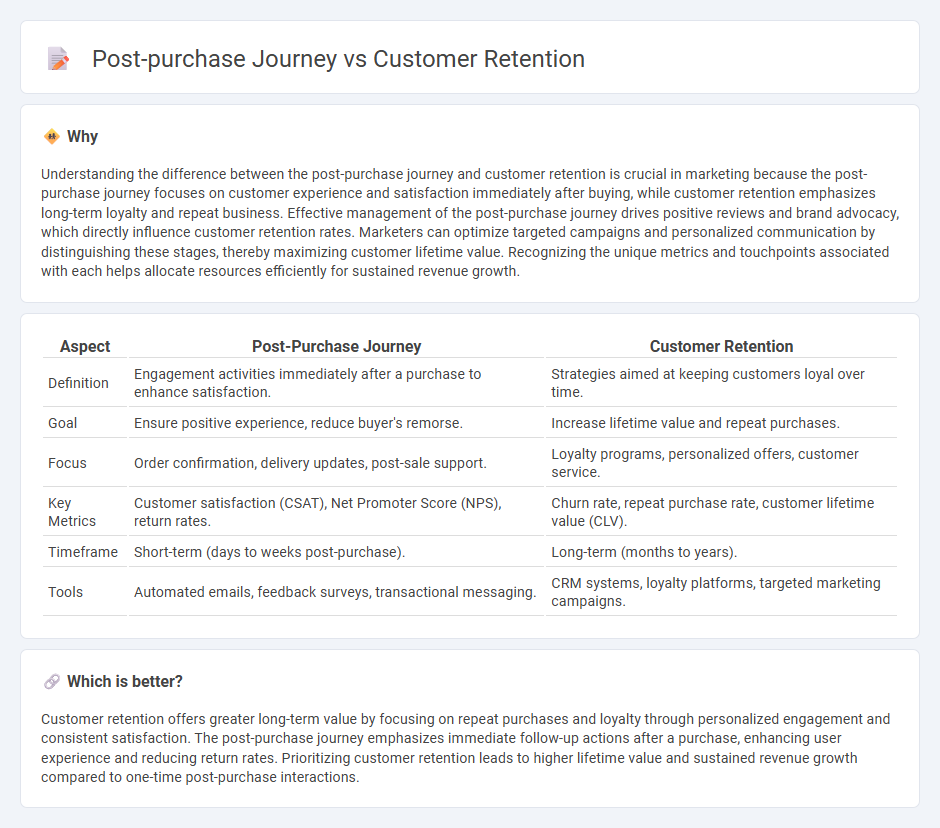
The post-purchase journey focuses on engaging customers immediately after a purchase to enhance satisfaction and encourage repeat buys. Customer retention strategies aim to build long-term loyalty through personalized experiences, consistent communication, and value-added services. Explore effective techniques to optimize both for sustained business growth.
Why it is important
Understanding the difference between the post-purchase journey and customer retention is crucial in marketing because the post-purchase journey focuses on customer experience and satisfaction immediately after buying, while customer retention emphasizes long-term loyalty and repeat business. Effective management of the post-purchase journey drives positive reviews and brand advocacy, which directly influence customer retention rates. Marketers can optimize targeted campaigns and personalized communication by distinguishing these stages, thereby maximizing customer lifetime value. Recognizing the unique metrics and touchpoints associated with each helps allocate resources efficiently for sustained revenue growth.
Comparison Table
| Aspect | Post-Purchase Journey | Customer Retention |
|---|---|---|
| Definition | Engagement activities immediately after a purchase to enhance satisfaction. | Strategies aimed at keeping customers loyal over time. |
| Goal | Ensure positive experience, reduce buyer's remorse. | Increase lifetime value and repeat purchases. |
| Focus | Order confirmation, delivery updates, post-sale support. | Loyalty programs, personalized offers, customer service. |
| Key Metrics | Customer satisfaction (CSAT), Net Promoter Score (NPS), return rates. | Churn rate, repeat purchase rate, customer lifetime value (CLV). |
| Timeframe | Short-term (days to weeks post-purchase). | Long-term (months to years). |
| Tools | Automated emails, feedback surveys, transactional messaging. | CRM systems, loyalty platforms, targeted marketing campaigns. |
Which is better?
Customer retention offers greater long-term value by focusing on repeat purchases and loyalty through personalized engagement and consistent satisfaction. The post-purchase journey emphasizes immediate follow-up actions after a purchase, enhancing user experience and reducing return rates. Prioritizing customer retention leads to higher lifetime value and sustained revenue growth compared to one-time post-purchase interactions.
Connection
The post-purchase journey plays a crucial role in customer retention by fostering ongoing engagement through personalized follow-ups, loyalty programs, and targeted support. Effective management of this phase enhances customer satisfaction and encourages repeat purchases, directly impacting lifetime value. Companies leveraging data analytics during the post-purchase stage can identify pain points and tailor experiences, reducing churn rates and boosting retention metrics.
Key Terms
Loyalty Programs
Loyalty programs play a crucial role in customer retention by incentivizing repeat purchases and fostering long-term brand commitment. These programs enhance the post-purchase journey through personalized rewards, exclusive offers, and seamless engagement, increasing customer lifetime value and satisfaction. Explore how optimized loyalty strategies can transform your post-purchase experience and boost retention rates.
Customer Feedback
Customer feedback is a critical component in both customer retention and the post-purchase journey, serving as a direct channel to gauge satisfaction and identify improvement areas. Leveraging feedback effectively helps businesses personalize experiences, resolve issues promptly, and foster long-term loyalty, thereby enhancing overall retention rates. Explore our in-depth analysis to understand how actionable customer insights can transform your retention strategy.
Personalized Communication
Personalized communication plays a crucial role in both customer retention and the post-purchase journey by tailoring messages to individual preferences and behaviors, enhancing customer satisfaction and loyalty. Effective segmentation and targeted content delivery ensure customers feel valued, increasing the likelihood of repeat purchases and long-term engagement. Discover strategies to leverage personalized communication and boost your customer retention rates.
Source and External Links
14 Customer Retention Strategies That Help Increase ROI - Customer retention involves increasing repeat purchases and extracting value from existing customers through strategies like loyalty programs, customer accounts, and personalized emails.
What is Customer Retention? - Customer retention is the rate at which customers stay with a business, improved by onboarding, personalized support, feedback use, and loyalty programs to reduce churn.
Customer retention: Metrics, strategies, and examples - A company retains customers by providing omnichannel support, quick responses, and personalized service to enhance the customer experience and encourage loyalty.
 dowidth.com
dowidth.com